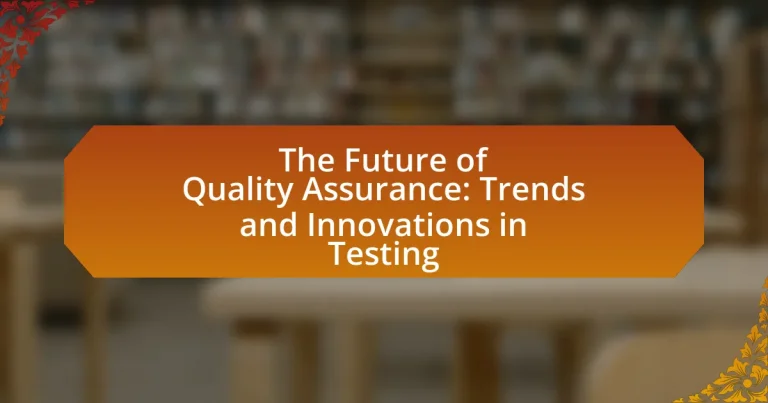The article focuses on the future of Quality Assurance (QA), highlighting emerging trends and innovations in testing practices. Key topics include the increased adoption of automation and artificial intelligence, which enhance testing efficiency and accuracy, as well as the importance of continuous testing in modern development environments. The article also discusses leading tools for test automation, the impact of DevOps on QA processes, and the challenges posed by the Internet of Things (IoT). Additionally, it outlines best practices for implementing effective QA strategies, fostering collaboration between QA and development teams, and avoiding common pitfalls in testing processes.

What are the emerging trends in Quality Assurance?
Emerging trends in Quality Assurance include the increased adoption of automation, the integration of artificial intelligence, and a focus on continuous testing. Automation enhances efficiency and accuracy in testing processes, allowing teams to execute repetitive tasks quickly. The integration of artificial intelligence enables predictive analytics and smarter test case generation, improving decision-making and resource allocation. Continuous testing, which aligns with DevOps practices, ensures that quality is maintained throughout the software development lifecycle, facilitating faster release cycles. These trends are supported by industry reports indicating that organizations implementing automation and AI in QA see up to a 30% reduction in testing time and a significant increase in defect detection rates.
How is automation transforming Quality Assurance practices?
Automation is transforming Quality Assurance practices by significantly increasing testing efficiency and accuracy. Automated testing tools enable faster execution of test cases, allowing teams to identify defects earlier in the development cycle. According to a report by the World Quality Report 2021-2022, organizations that implemented automation saw a 30% reduction in testing time and a 25% increase in test coverage. This shift not only accelerates the release of software products but also enhances the overall quality by minimizing human error and ensuring consistent testing processes.
What tools are leading the way in test automation?
The tools leading the way in test automation include Selenium, TestComplete, and Cypress. Selenium is widely recognized for its flexibility and support for multiple programming languages, making it a popular choice among developers and testers. TestComplete offers a user-friendly interface and robust features for both web and mobile applications, enabling teams to create automated tests without extensive coding knowledge. Cypress stands out for its real-time testing capabilities and easy integration with modern JavaScript frameworks, which enhances developer productivity. These tools are validated by their widespread adoption in the industry, with Selenium being used by over 1 million websites, TestComplete being favored by numerous Fortune 500 companies, and Cypress gaining traction in the developer community for its speed and reliability.
How does automation impact testing efficiency and accuracy?
Automation significantly enhances testing efficiency and accuracy by streamlining repetitive tasks and reducing human error. Automated testing tools can execute test cases faster than manual testing, allowing for more tests to be run in a shorter time frame. For instance, according to a study by the International Journal of Advanced Computer Science and Applications, automated testing can reduce testing time by up to 70%, enabling quicker feedback and faster release cycles. Additionally, automation ensures consistent execution of tests, which minimizes discrepancies that can arise from human intervention, thereby increasing the reliability of test results.
What role does artificial intelligence play in Quality Assurance?
Artificial intelligence plays a crucial role in Quality Assurance by automating testing processes, enhancing accuracy, and improving efficiency. AI algorithms can analyze vast amounts of data to identify patterns and predict potential defects, which significantly reduces the time required for manual testing. For instance, according to a report by McKinsey, organizations that implement AI in their testing processes can achieve up to 30% faster release cycles and a 50% reduction in testing costs. Additionally, AI-driven tools can perform regression testing and load testing more effectively, ensuring that software meets quality standards before deployment.
How can AI enhance test case generation and execution?
AI can enhance test case generation and execution by automating the creation of test cases based on application requirements and historical data. This automation allows for the rapid generation of comprehensive test suites that cover various scenarios, reducing manual effort and increasing test coverage. For instance, AI algorithms can analyze user behavior and application logs to identify critical paths and edge cases, ensuring that the most relevant tests are executed. Additionally, AI can optimize test execution by prioritizing test cases based on risk assessment and historical failure rates, leading to more efficient testing cycles. Studies have shown that organizations implementing AI-driven testing solutions can achieve up to 30% faster test cycles and a significant reduction in defects, validating the effectiveness of AI in enhancing quality assurance processes.
What are the challenges of integrating AI into Quality Assurance?
Integrating AI into Quality Assurance presents several challenges, including data quality, algorithm bias, and the need for skilled personnel. Data quality is crucial because AI systems require large volumes of accurate and relevant data to function effectively; poor data can lead to incorrect conclusions and ineffective testing. Algorithm bias occurs when AI models are trained on biased data, resulting in skewed outcomes that can compromise the integrity of quality assurance processes. Additionally, the integration of AI necessitates skilled personnel who understand both AI technologies and quality assurance methodologies; a shortage of such expertise can hinder successful implementation. These challenges highlight the complexities involved in effectively incorporating AI into quality assurance practices.
Why is continuous testing becoming essential in modern development?
Continuous testing is becoming essential in modern development because it enables rapid feedback and ensures software quality throughout the development lifecycle. This approach allows teams to identify defects early, reducing the cost and time associated with fixing issues later in the process. According to the World Quality Report 2021-2022, organizations that implement continuous testing can achieve up to 30% faster release cycles and a 25% reduction in post-release defects. These statistics highlight the critical role of continuous testing in enhancing efficiency and maintaining high-quality standards in software development.
What methodologies support continuous testing in Agile environments?
Agile methodologies that support continuous testing include Test-Driven Development (TDD), Behavior-Driven Development (BDD), and Continuous Integration/Continuous Deployment (CI/CD). TDD emphasizes writing tests before code, ensuring that testing is integral to the development process. BDD focuses on collaboration between developers, testers, and business stakeholders to define test cases in natural language, enhancing understanding and communication. CI/CD practices automate the integration and deployment processes, allowing for frequent testing and immediate feedback on code changes. These methodologies collectively enhance the quality and speed of software delivery in Agile environments by embedding testing throughout the development lifecycle.
How does continuous testing improve software delivery timelines?
Continuous testing improves software delivery timelines by enabling faster feedback on code changes, which accelerates the development process. By integrating testing into the continuous integration and continuous deployment (CI/CD) pipeline, teams can identify defects early, reducing the time spent on fixing issues later in the development cycle. Research indicates that organizations implementing continuous testing can achieve up to 30% faster release cycles, as reported by the World Quality Report 2020-21. This efficiency is primarily due to automated testing processes that run concurrently with development, allowing for immediate validation of new features and ensuring that quality is maintained throughout the development lifecycle.

What innovations are shaping the future of testing?
Innovations shaping the future of testing include automation, artificial intelligence, and continuous testing methodologies. Automation enhances efficiency by reducing manual effort and increasing test coverage, while artificial intelligence improves test case generation and defect prediction through machine learning algorithms. Continuous testing methodologies enable faster feedback loops in DevOps environments, ensuring that quality assurance is integrated throughout the software development lifecycle. These innovations are supported by industry trends, such as the increasing adoption of Agile and DevOps practices, which emphasize rapid delivery and iterative improvements in software quality.
How are cloud-based testing solutions changing the landscape?
Cloud-based testing solutions are transforming the landscape by enabling scalable, flexible, and cost-effective testing environments. These solutions allow organizations to access a wide range of testing tools and resources on-demand, reducing the need for extensive on-premises infrastructure. According to a report by MarketsandMarkets, the cloud testing market is projected to grow from $29.5 billion in 2020 to $63.5 billion by 2025, highlighting the increasing adoption of these solutions. This shift facilitates faster testing cycles, improved collaboration among distributed teams, and enhanced test coverage, ultimately leading to higher quality software delivery.
What advantages do cloud testing platforms offer over traditional methods?
Cloud testing platforms provide scalability, cost-effectiveness, and enhanced collaboration compared to traditional testing methods. These platforms allow organizations to quickly scale their testing environments up or down based on demand, which is particularly beneficial for handling varying workloads. Additionally, cloud testing reduces infrastructure costs since users only pay for the resources they consume, eliminating the need for extensive on-premises hardware. Furthermore, cloud platforms facilitate real-time collaboration among distributed teams, enabling faster feedback and more efficient workflows. This is supported by a report from Gartner, which indicates that 70% of organizations using cloud testing experience improved collaboration and reduced time-to-market.
How does cloud testing facilitate collaboration among teams?
Cloud testing facilitates collaboration among teams by providing a centralized platform that enables real-time access to testing environments and resources. This accessibility allows team members from different locations to work together seamlessly, share insights, and address issues promptly. For instance, cloud testing tools often include features like version control, automated reporting, and integrated communication channels, which enhance transparency and streamline workflows. Research indicates that organizations utilizing cloud-based testing solutions experience a 30% increase in team productivity due to improved collaboration and reduced time spent on setup and maintenance of testing environments.
What is the significance of DevOps in Quality Assurance?
DevOps significantly enhances Quality Assurance by integrating development and operations teams, which fosters collaboration and accelerates the software delivery process. This integration allows for continuous testing and feedback, ensuring that quality is maintained throughout the development lifecycle. According to the 2021 State of DevOps Report, organizations that implement DevOps practices experience 46 times more frequent code deployments and 96 times faster mean time to recovery from failures, demonstrating the effectiveness of DevOps in improving quality assurance outcomes.
How does DevOps culture influence testing practices?
DevOps culture significantly influences testing practices by promoting continuous integration and continuous delivery (CI/CD), which encourages early and frequent testing throughout the software development lifecycle. This approach leads to faster feedback loops, allowing teams to identify and resolve defects more quickly. For instance, a study by Puppet and DORA in 2020 found that high-performing DevOps teams deploy code 46 times more frequently than their low-performing counterparts, highlighting the importance of integrated testing in achieving rapid deployment. Additionally, DevOps fosters collaboration between development and operations teams, which enhances communication and ensures that testing is aligned with business objectives, ultimately improving software quality and reliability.
What tools are commonly used in DevOps for Quality Assurance?
Commonly used tools in DevOps for Quality Assurance include Selenium, JUnit, TestNG, Jenkins, and SonarQube. Selenium is widely recognized for automated web application testing, while JUnit and TestNG are popular frameworks for unit testing in Java applications. Jenkins serves as a continuous integration and continuous delivery tool that automates testing processes, and SonarQube is utilized for code quality analysis. These tools collectively enhance the efficiency and effectiveness of quality assurance practices in DevOps environments.
How is the Internet of Things (IoT) impacting Quality Assurance?
The Internet of Things (IoT) is significantly impacting Quality Assurance by enabling real-time monitoring and data collection from connected devices. This integration allows for more efficient testing processes, as continuous feedback from IoT devices helps identify defects and performance issues earlier in the development cycle. For instance, according to a report by Gartner, organizations that implement IoT solutions can reduce their testing time by up to 30%, as automated testing frameworks can leverage data from these devices to enhance test coverage and accuracy. This shift towards data-driven quality assurance not only improves product reliability but also accelerates time-to-market for IoT-enabled products.
What unique challenges does IoT testing present?
IoT testing presents unique challenges primarily due to the complexity and diversity of interconnected devices. The vast number of devices, varying communication protocols, and the need for real-time data processing complicate the testing process. Additionally, ensuring security and privacy across multiple platforms and environments adds another layer of difficulty. According to a report by Gartner, by 2025, there will be over 75 billion connected devices, highlighting the scale at which IoT testing must operate. This complexity necessitates specialized testing strategies that can accommodate the dynamic nature of IoT ecosystems.
How can organizations prepare for IoT testing requirements?
Organizations can prepare for IoT testing requirements by implementing a comprehensive testing strategy that encompasses device interoperability, security, and performance. This involves establishing a robust testing framework that includes automated testing tools, continuous integration, and real-time monitoring to ensure that IoT devices function seamlessly within their ecosystems. Additionally, organizations should invest in training their teams on IoT-specific testing methodologies and best practices, as well as collaborating with industry standards bodies to stay updated on evolving testing protocols. By adopting these measures, organizations can effectively address the complexities of IoT environments and enhance the reliability of their products.

What best practices should be adopted for future Quality Assurance?
To enhance future Quality Assurance, organizations should adopt automation, continuous testing, and a shift-left approach. Automation streamlines repetitive tasks, increases efficiency, and reduces human error, as evidenced by a report from the World Quality Report 2021-2022, which indicates that 70% of organizations using automation in testing saw improved quality outcomes. Continuous testing integrates testing into the development process, allowing for immediate feedback and faster release cycles, aligning with Agile and DevOps methodologies. The shift-left approach emphasizes early testing in the software development lifecycle, which can reduce defect rates by up to 40%, according to research by the IBM Institute for Business Value. These best practices collectively foster a proactive quality culture, ensuring higher software quality and customer satisfaction.
How can teams effectively implement test automation?
Teams can effectively implement test automation by establishing a clear strategy that includes selecting the right tools, defining test cases, and integrating automation into the development process. A well-defined strategy ensures that automation aligns with project goals and addresses specific testing needs. For instance, using tools like Selenium or TestComplete can streamline the automation of web applications, while frameworks such as JUnit or NUnit are suitable for unit testing.
Additionally, teams should prioritize the creation of maintainable and reusable test scripts, which can significantly reduce the time and effort required for future testing cycles. According to a study by the International Journal of Advanced Computer Science and Applications, organizations that adopt test automation report a 30% reduction in testing time and a 25% increase in test coverage. This data underscores the effectiveness of a structured approach to test automation, highlighting its potential to enhance overall software quality and efficiency.
What are the key steps in developing a test automation strategy?
The key steps in developing a test automation strategy include defining objectives, selecting the right tools, identifying test cases for automation, establishing a framework, and implementing continuous integration. Defining objectives ensures alignment with business goals, while selecting the right tools involves evaluating options based on project requirements and team expertise. Identifying test cases for automation focuses on prioritizing tests that are repetitive, time-consuming, or prone to human error. Establishing a framework provides a structured approach for test development and execution, and implementing continuous integration facilitates regular testing and feedback. These steps are essential for creating an effective and efficient test automation strategy that enhances software quality and accelerates delivery.
How can teams measure the success of their automation efforts?
Teams can measure the success of their automation efforts by evaluating key performance indicators (KPIs) such as test coverage, defect density, and time savings. For instance, increased test coverage indicates that a larger portion of the application is being tested automatically, which can lead to higher quality assurance. Additionally, a reduction in defect density, measured by the number of defects found in production relative to the number of tests executed, demonstrates the effectiveness of automation in identifying issues early. Time savings can be quantified by comparing the time taken to execute tests manually versus automatically, with significant reductions indicating successful automation implementation. These metrics provide concrete evidence of the impact of automation on the quality assurance process.
What strategies can enhance collaboration between QA and development teams?
To enhance collaboration between QA and development teams, implementing integrated communication tools is essential. These tools facilitate real-time discussions, issue tracking, and feedback sharing, which can significantly reduce misunderstandings and streamline workflows. For instance, using platforms like Jira or Slack allows both teams to stay aligned on project goals and timelines, fostering a culture of transparency. Research indicates that organizations employing collaborative tools see a 20-30% increase in productivity, as teams can address issues promptly and efficiently. Additionally, regular joint meetings and shared objectives can further strengthen the partnership, ensuring that both QA and development are working towards common goals.
How can communication tools improve team dynamics?
Communication tools can significantly improve team dynamics by facilitating real-time collaboration and enhancing information sharing. These tools enable team members to communicate instantly, reducing misunderstandings and fostering a culture of transparency. For instance, platforms like Slack or Microsoft Teams allow for organized discussions, which can lead to quicker decision-making and increased productivity. Research indicates that teams using effective communication tools report a 25% increase in collaboration efficiency, as highlighted in a study by the Project Management Institute. This improvement in communication directly correlates with higher team morale and cohesion, ultimately leading to better project outcomes in quality assurance processes.
What role does feedback play in fostering collaboration?
Feedback plays a crucial role in fostering collaboration by enhancing communication and promoting continuous improvement among team members. When individuals receive constructive feedback, it encourages open dialogue, clarifies expectations, and aligns goals, which are essential for effective teamwork. Research indicates that organizations with a strong feedback culture experience higher levels of employee engagement and productivity, as seen in a study by Gallup, which found that teams that receive regular feedback have a 14.9% lower turnover rate. This demonstrates that feedback not only strengthens interpersonal relationships but also drives collective performance, making it a vital component of successful collaboration.
What are the common pitfalls to avoid in Quality Assurance?
Common pitfalls to avoid in Quality Assurance include inadequate test planning, insufficient test coverage, and lack of communication among team members. Inadequate test planning can lead to missed requirements and untested scenarios, resulting in software defects. Insufficient test coverage may leave critical functionalities untested, increasing the risk of failures in production. Lack of communication can cause misunderstandings about project goals and testing priorities, ultimately affecting the quality of the final product. These pitfalls are supported by industry reports indicating that organizations with structured QA processes experience up to 40% fewer defects in production.
How can teams identify and mitigate risks in testing processes?
Teams can identify and mitigate risks in testing processes by implementing structured risk assessment methodologies, such as Failure Mode and Effects Analysis (FMEA) and risk-based testing. These methodologies allow teams to systematically evaluate potential failure points and their impacts on the overall testing process. For instance, FMEA helps teams prioritize risks based on their severity and likelihood, enabling focused resource allocation to the most critical areas. Additionally, regular reviews and updates of risk assessments throughout the testing lifecycle ensure that new risks are identified and addressed promptly. This proactive approach is supported by industry practices, where organizations that adopt risk-based testing report a 30% reduction in critical defects, demonstrating the effectiveness of these strategies in enhancing testing quality and efficiency.
What practices can prevent burnout among QA professionals?
To prevent burnout among QA professionals, implementing regular breaks and promoting a healthy work-life balance are essential practices. Research indicates that taking short breaks during work hours can enhance productivity and reduce stress levels, which are critical for maintaining mental well-being. Additionally, fostering an environment that encourages open communication and support among team members can help identify stressors early and mitigate their impact. A study published in the Journal of Occupational Health Psychology found that employees who engage in supportive workplace relationships experience lower levels of burnout. Furthermore, providing opportunities for professional development and skill enhancement can keep QA professionals motivated and engaged, reducing feelings of stagnation that often lead to burnout.


